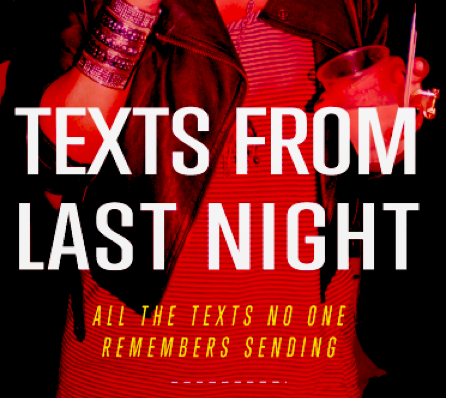You are here
Introducing Analysis with "Texts From Last Night"
Primary tabs

Screen shot of Texts From Last Night website
Using samples pulled from the popular website, Texts From Last Night, this exercise introduces students to textual analysis in a fun and (most likely) funny way. Students are asked how much and what kinds of information they can glean from a very small piece of text.
To introduce students to textual analysis - either close reading or rhetorical analysis - using a very small piece of text.
No hardware required - could be completed with handouts.
Ideally, lesson would take place using a media console.
Using samples pulled from the popular website, Texts From Last Night, this exercise introduces students to textual analysis in a fun and (most likely) funny way. Students are asked how much and what kinds of information they can glean from a very small piece of text.
If you aren't familiar with the website, Texts From Last Night, it's a blog dedicated to public submissions of funny, lewd, or ridiculous text messages received "last night." The site has both a twitter presence and a facebook following, so many students will already be familiar with it. Those that are familiar with it will probably be a bit surprised to see it turn up in a classroom, as most of the messages tend to include either drinking references or discussions of sexual escapades. So, the material is often a bit scandalous - which is why the instructor should be certain to pre-select material for analysis. It's probably a very bad idea to actually pull the website up in class. Set aside about 20 minutes to half an hour the night before class to troll the site for material. You can take screen shots of the texts you'd like to look at and then post them to your class blog, wiki, site, etc. or simply copy them onto a handout.
One of the goals of this course is to teach you the practice of close reading, or a very detailed analysis of language. You might be surprised just how much information can be gleaned from a very small piece of text - but you'll also need to practice separating your assumptions from evidence-based analysis.
As a class, we'll take a look at some sample texts pulled from the website, Texts From Last Night. These sample text messages are very short (originating from real text messages), but they can contain a wealth of information - about the sender, their relationship to the recipient, the reason for sending the text, the sender's current or previous location... any number of important clues for deciphering the meaning of the text. (i.e. the relationships in the rhetorical triangle).
First, what can you tell about either the sender or the recipient of the text? What is their relationship? How do you know?
What is the text message saying? What is the content of the message/the reason for sendign it? Is it just to be funny? Does the sender want to persuade the recipient of something? Is the sender making a request?
Where is the sender now? Is the recipient somewhere else (as in far away)?
What does the message indicate in terms of time or chronology? What is the kairotic moment in which the text was sent?
This was an in-class discussion assignment, so no evaluation was necessary.
I used this exercise on the very first day of class, and my students loved it. They were both surprised and delighted by the use of a seemingly trivial pop culture phenomena, and (of course) a bit titilated by the content. Since I try to cultivate an open and fun environment in my classroom, this set the tone well for my semi-informal ethos.
It was also a great way to start reigning in their conjectures. While many students wanted to make broad or sweeping claims about the messages and their senders, this was a great way to point out the difference between assumptions and evidence-based analysis. I asked them to stick very closely to the text itself and show me where they were getting their ideas.
Here are some sample texts that I used to introduce rhetorical concepts.
ETHOS:
PATHOS:
LOGOS:
The broad goals of this course will be to introduce students to the basic tools of literary analysis and to develop students’ own critical writing.
-

- Log in to post comments




